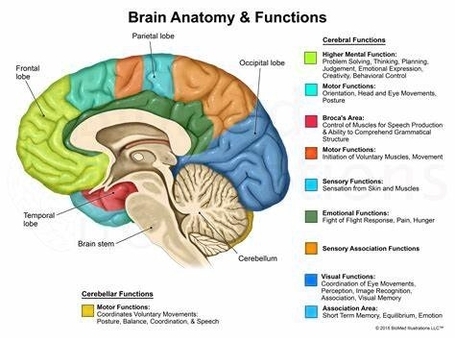Parts Of The Brain Diagram And Function

The human brain, the most complex organ in the body, is responsible for controlling thought, memory, emotion, touch, motor skills, vision, breathing, temperature, hunger, and every process that regulates our body. It is made up of billions of neurons and has several specialized parts, each involved in important functions.
1. Cerebrum
The cerebrum, the largest part of the brain, initiates and coordinates movement and regulates temperature. It comprises gray matter (the cerebral cortex) and white matter at its center. The cerebral cortex is responsible for higher-order functions such as consciousness, imagination, information processing, language, memory, perception, reasoning, sensation, and voluntary physical action. It is divided into four lobes:
– Frontal Lobe: Associated with reasoning, motor skills, higher-level cognition, and expressive language. Damage to this lobe can lead to changes in sexual habits, socialization, attention, and increased risk-taking.
– Parietal Lobe: Processes tactile sensory information such as pressure, touch, and pain.
– Occipital Lobe: Responsible for vision.
– Temporal Lobe: Interprets sounds and language we hear. It also heavily associated with the formation of memories.
2. Cerebellum
The cerebellum coordinates balance and muscle activity. It plays a vital role in motor control and is also involved in some cognitive functions such as attention and language, and in regulating fear and pleasure responses.
3. Brainstem
The brainstem controls basic functions like breathing. It acts as a relay center connecting the cerebrum and cerebellum to the spinal cord, performing many automatic functions such as breathing, heart rate, body temperature, wake and sleep cycles, digestion, sneezing, and coughing.
4. Diencephalon
The diencephalon regulates processes like sleep and body temperature. It consists of structures such as the thalamus and hypothalamus which are responsible for such functions as motor control, relaying sensory information, and controlling autonomic functions.
5. Limbic System
The limbic system, often referred to as the “emotional brain”, is involved in many of our emotions and motivations, particularly those related to survival such as fear and anger.
6. Gray and White Matter
Gray matter is primarily composed of neuron somas (the round central cell bodies), and white matter is mostly made of axons (the long stems that connect neurons together) wrapped in myelin (a protective coating). Gray matter is primarily responsible for processing and interpreting information, while white matter transmits that information to other parts of the nervous system.
In conclusion, the brain is a complex organ with various parts working together to regulate and control bodily functions. Each part plays a unique role, and understanding these parts can help us understand how disease and damage may affect the brain and its ability to function..
